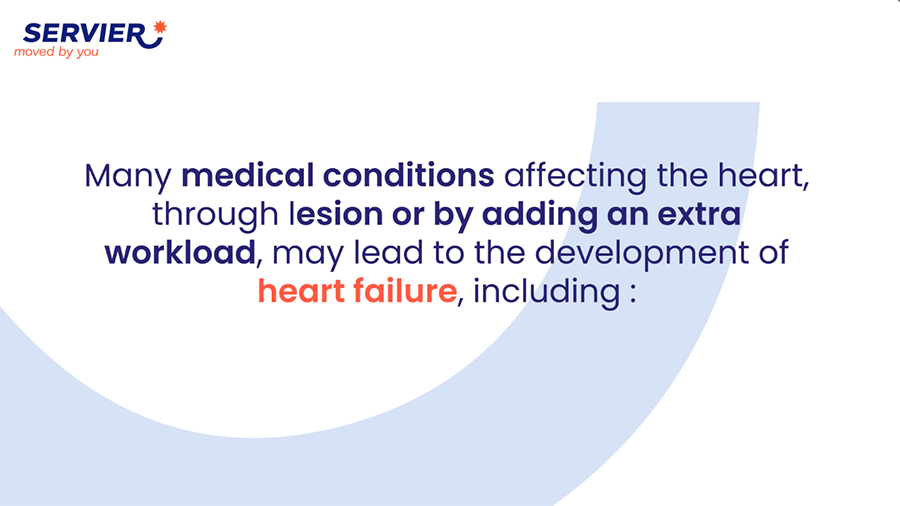Shortness of breath, fatigue, ankle edema… Heart failure, which can have multiple causes, creates numerous difficulties in daily life, markedly impacting patient quality of life. However, this serious condition can be stabilized through lifestyle changes and medication (or surgical treatment in certain cases).
Heart failure is characterized by the heart’s inability to drain and pump blood normally to and from the rest of the organs, resulting in poor oxygenation of the organs and accumulation of fluids (edema). This debilitating disease is often age-related. It can, however, occur in younger individuals, sometimes with malformed heart valves.
64 million
Heart failure affects 64 million people worldwide1
1% – 3%
Prevalence in Western countries (European Union, North America) is between 1% and 3%. Some Asian countries report much higher figures: 6% in Taiwan, 5% in Indonesia2.
1.4 billion
Heart failure is on the increase as people age. By 2030, one in six people worldwide will be aged 60 or over. By then, the proportion of the population aged 60 and over will have risen from 1 billion in 2020 to 1.4 billion.3
The heart, a pump that wears out
The heart is comprised of four chambers (two atria and two ventricles) that contract in a coordinated manner to send blood to the lungs for reoxygenation, and then to the rest of the body. This pumping action is performed by the myocardium, a muscle that is irrigated by the coronary arteries.

When the heart loses some of its muscular strength and normal contraction capacity, we speak of heart failure. It no longer pumps enough blood, so the body does not receive the oxygen it needs. First manifesting itself during exercise, then at rest, it forces the heart to compensate by working harder: first, by accelerating the heart rate; then by increasing the volume of the heart (dilatation of cavities, thickening of walls).
First symptoms: edema, shortness of breath and fatigue
The slowdown in blood circulation leads to an accumulation of blood in the vessels, increasing the pressure on their walls. This causes fluid to leak into the tissues, leading to edema, particularly in the ankles and feet.
Increased blood pressure in the pulmonary vessels prevents the lungs from functioning properly. This discomfort manifests itself as breathlessness and difficulty in catching one’s breath on exertion, then for progressively smaller efforts, and then at rest.
Another suggestive symptom is fatigue, caused by a lack of irrigation to the muscles, which are deprived of an adequate supply of nutrients and oxygen.
Finally, heart failure also leads to water and salt retention due to reduced kidney activity, which can result in rapid, unexplained weight gain. In the presence of one or more of these symptoms, it is advisable to consult a doctor as soon as possible.
60-100 bpm is the heart’s normal rhythm.4
It can reach 130-150 bpm during exercise. However, if you have any symptoms or suspect that your pulse is irregular, tell your doctor.

Doppler to monitor cardiac activity
In addition to a clinical examination and blood tests, heart failure is diagnosed on the basis of an electrocardiogram (including an exercise tolerance test for young subjects) and imaging.
Doppler echocardiography measures the size of the heart chambers and the thickness of the muscle. It also assesses the filling capacity and contraction of the left ventricle, responsible for propelling blood to the body. Depending on the results, a distinction is made between heart failure with reduced ejection fraction and that with normal ejection fraction.
Certain markers in the blood (BNP/NT-proBNP) help determine whether worsening fatigue or shortness of breath are due to heart failure or not. BNP/NT-proBNP is released in the heart in response to pressure increases inside the heart. In patients with heart failure, BNP and NT-proBNP levels are higher than in patients with normal cardiac function.
The doctor also analyses cardiovascular risk factors, such as diabetes, atherosclerosis (fatty deposits on the walls of the arteries), smoking, excess weight, and the presence of hypertension or coronary artery disease.
Medication and lifestyle
Adopting a healthier lifestyle is crucial to preserving the heart: stopping smoking, modifying eating habits (less fat, alcohol, salt), practicing moderate physical activity, limiting fluid intake to reduce the risk of edema…
The treatment of heart failure involves a combination of several treatments with complementary mechanisms of action5. However, beyond the specific treatment of heart failure, it is equally important to target its risk factors, for example by treating coronary artery disease (including angina pectoris), hypertension and dyslipidemia, or by operating on a failing heart valve.

AND SERVIER?
As the world’s 5th largest cardiology group6, Servier has been involved in cardiovascular diseases for over 60 years. We intend to maintain our leadership position through strategic and innovative management of the life cycle of our medicines. We are capitalizing on our know-how in incremental innovation, notably in the development of Single Pill Combinations, medicines combined in a single tablet, designed to simplify treatment and improve compliance.
Remember
Heart failure is a life-threatening condition that requires regular medical follow-up, including consultations with a doctor at least every six months until it has stabilized. We also strongly recommend:
[1] GBD 2017 Disease and Injury Incidence and Prevalence Collaborators. Global, regional, and national incidence, prevalence, and years lived with disability for 354 diseases and injuries for 195 countries and territories, 1990–2017: a systematic analysis for the Global Burden of Disease Study 2017. Lancet 2018;392:1789–1858 https://www.thelancet.com/article/S0140-6736(18)32279-7/fulltext
[2] Reyes EB, Ha JW, Firdaus I, Ghazi AM, Phrommintikul A, Sim D, Vu QN, Siu CW, Yin WH, Cowie MR. Heart failure across Asia: same healthcare burden but differences in organization of care. Int J Cardiol 2016;223:163–167. https://pubmed.ncbi.nlm.nih.gov/27541646/
[3] World Health Organization – Ageing and health – https://www.who.int/news-room/fact-sheets/detail/ageing-and-health
[4] National Cancer Institute. Definition of heart rate – NCI Dictionary of Cancer Terms. 2011. https://www.cancer.gov/publications/dictionaries/cancer-terms/def/heart-rate
[5] ESC Guidelines 2021; McDonagh et al. European Heart Journal (2021) 42, 3599-3726 https://pubmed.ncbi.nlm.nih.gov/34447992/
[6] IQVIA, Analytics Link / World 74 countries – MAT Q1-2024
